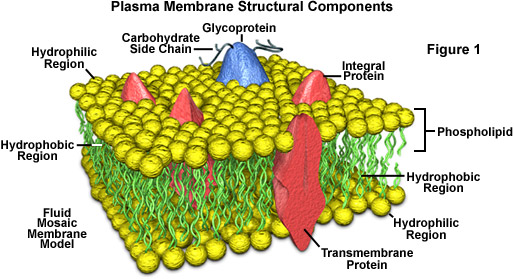Re: GAMSAT Biology Cell Membrane
One of the topics frequently brought up in the GAMSAT Section III is Cell Biology. This topic encompasses the basic structures of the cell, cell membrane and membrane transport etc.
In this post we will cover Cell Membrane Biology.
So, let’s get started!
The membrane that encases all living cells is a bilayer formed of phospholipids called the Cell membrane. This can also be called a plasma membrane.
Structure
The fluid mosaic model describes the membrane as being fluid-like, with a mosaic of proteins floating inside.
The cell membrane consists of four component groups.
- Phospholipid bilayer: Every cell membrane has a phospholipid bilayer. Many components of the membrane are embedded in this bilayer.
- Membrane proteins: This collection of proteins floats in the lipid bilayer. Integral proteins are embedded in the membrane and peripheral proteins are associated with the surface of the membrane.
- Interior protein network: Intracellular proteins provide structural support to the membrane.
- Cell-surface markers: The membrane has glycoproteins and glycolipids, which act as cell identity markers.
Phospholipids spontaneously form bilayers. They are composed of two fatty acids and a phosphate group linked to a 3-carbon glycerol molecule.
The phosphate group of the phospholipid is hydrophilic (water-loving). The fatty acids are hydrophobic (water-hating) and non-polar.
The fluidity of the membrane depends on the composition of fatty acids in the membrane. Unsaturated fatty acids make the membrane more fluid and saturated fatty acids make the membrane less fluid-like. Temperature also affects the fluidity of the membrane.
Transport across the membrane can occur via diffusion, which is a type of passive transport. No energy is required for passive diffusion and it involves moving a substance along a chemical or electrical gradient. The cell membrane creates a barrier to hydrophilic polar molecules, while they allow for hydrophobic substances to diffuse through.
Ions and large hydrophilic molecules cannot directly pass through the phospholipid bilayer. However, these molecules can still pass through with the help of proteins. This process is known as facilitated diffusion. The proteins can either be carriers or channels. Channels allow for the diffusion of ions through a protein channel whilst carriers bind to the molecules they transport.
The process of water moving across the membrane is termed osmosis. Water will move to an area with a higher concentration of solutes or to an area with a lower concentration of water.
Active transport involves the use of energy to move substances against a concentration gradient. Specialised protein carriers are used with a source of energy to transport substances. There are different types of transporters:
Uniporters – transport a specific molecule in one direction.
Symporters – transport two molecules in the same direction.
Antiporters – transport two molecules in opposite directions.
The cell membrane contains a sodium-potassium pump. This pump uses ATP and moves sodium out of the cell and potassium into the cell against their concentration gradients.
Large quantities of substances cannot pass through the membrane by diffusion. Large quantities of substances must enter the cell via endocytosis, which involves the cell membrane surrounding the material and pinching off to form a vesicle. Large quantities of material can leave via exocytosis. This involves the material being release from the cell when the vesicle fuses with the membrane.
As mentioned at the beginning of this post, this topic is frequently brought up in the GAMSAT exam however keep in mind that it might not come up at all! Those sitting the GAMSAT will still need to work on having a solid background and a clear understanding of this topic which will prepare them for any GAMSAT questions that might arise.


